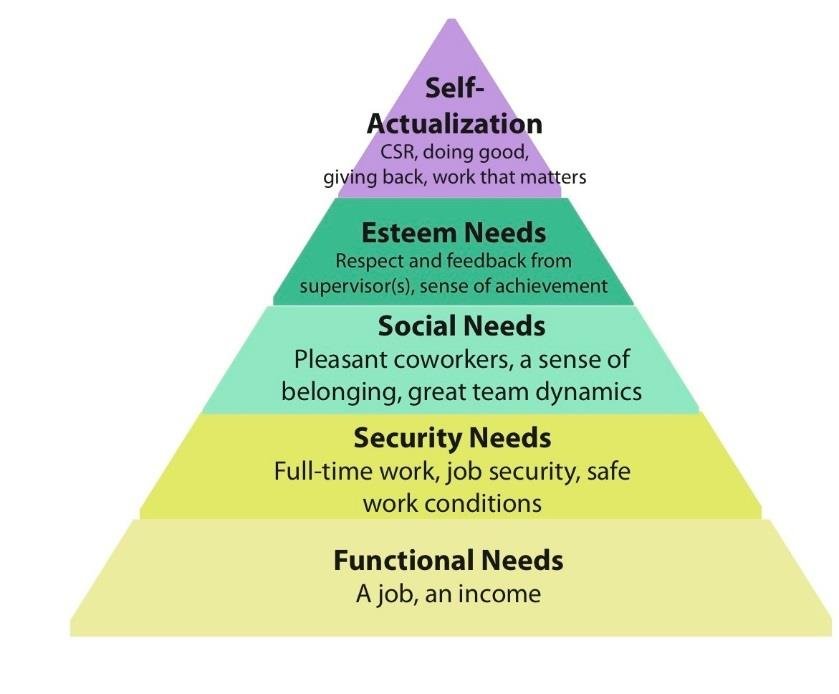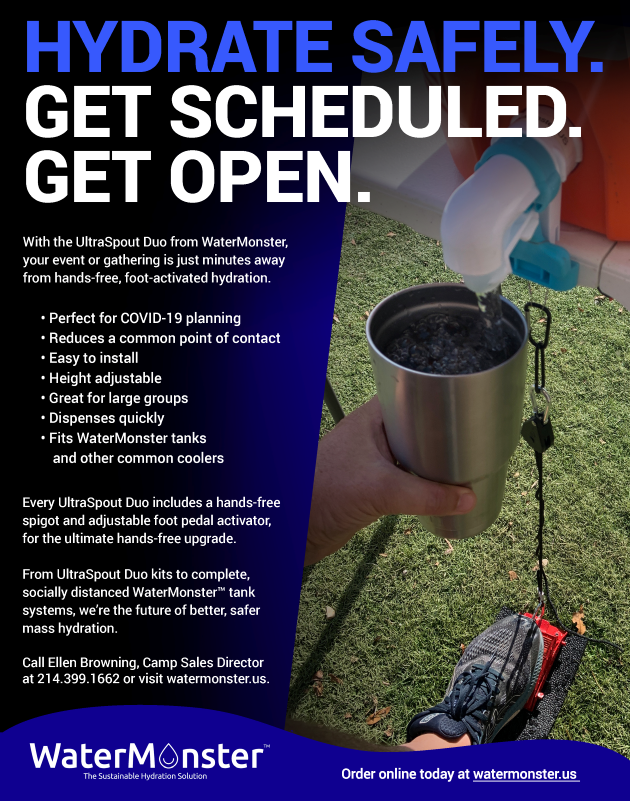We know that staff can be a challenge to find, attract, hire, engage, and retain. What makes the staff journey result in forward progress from start to completion of their camp experience? Current research and promising practices provide information that can help camps succeed throughout this cycle. Join us as we take a look at some of those contributing factors.
At every step along the way, it is important to consider the needs of staff and the emotions they might feel before we develop specific actions to address each stage. We all have varying needs that contribute to our overall wellness, including:
- Physical
- Emotional
- Social
- Occupational
- Spiritual
- Environmental
- Financial
- Intellectual
As an employer, addressing these needs may seem counterintuitive, but if we are going to attract, hire, and retain quality staff, we must understand applicants as holistic beings.
For example, recognition that this might be a person’s first job application might lead to sharing information about what to expect during the interview process. The applicant may be feeling apprehensive and uncertain, so we could provide tips about how to prepare and dress for the interview. Some camps provide this information on the staff section of their websites in addition to mentioning it in a text, email, or conversation with the individual. In this way the needs and feelings of prospective staff members are taken into consideration in this phase of the hiring process.
Explore
Questions we hear a lot are “Where do camps find prospective staff?” and “Where are young adults looking for summer jobs?” While new staff certainly can be recent high school graduates or those already in the workforce, the majority of camp staff are college students. So we posed the question to students and faculty members in parks and recreation degree programs as well as existing staff. Their most frequent responses were “Indeed,” “Handshake” (a virtual hiring platform used by many universities), “faculty-curated job lists,” “CoolWorks,” and “TikTok.” As camp is explored for a potential summer opportunity, it is important that messaging builds excitement and a desire to know more.
Excite
Taking a look at Maslow’s hierarchy of needs as applied to the workforce (Sewpersadh, 2016) can help us understand what excites or motivates staff to become engaged and committed (see Figure 1). Having a paid job is at the functional needs level; in addition, the decision to work may be influenced by parents or school requirements. At the next level, there are safe job conditions, which include emotional, social, and psychological safety. If these lower-level needs are not met, they may serve as de-motivators and contribute to disengagement.

Figure 1: The Millennial Hierarchy of Workplace Needs.
Inclusive team dynamics and a sense of community can satisfy the social needs of an individual (mid-pyramid). We recommend that this not wait until the start of orientation training, but rather that steps be taken so staff feel they are vital members and part of something bigger early on.
Feeling respected and receiving feedback from supervisors, in addition to staff feeling a sense of achievement, contribute to meeting staff esteem needs. At the top of the pyramid, we see self-actualization needs that are fulfilled when someone has a sense that the work they do matters. Camp is the perfect ecosystem for reaching the top of this hierarchy if the needs at lower levels of the pyramid are met first.
Other factors that excite potential staff about working at camp include seeing connections to future careers (which may come in the form of internship possibilities), flexibility in work arrangements (such as shorter shifts for day camp staff or part-time opportunities for overnight staff), and being able to stay connected to friends and family (even though camp is largely “unplugged”).
Showing staff how they can advance in future summers to positions involving more responsibility and leadership can plant the seed for working at camp beyond one season. Fair compensation, including benefits in addition to the paycheck (e.g., time-off, professional development opportunities, letters of recommendation), are also key to a potential applicant taking the next step.
Embark
Once prospects become excited about the opportunity to work at camp, they embark on the process of applying. Because first impressions are so critical at this phase, it is to the camp’s advantage to avoid gatekeeping hurdles that could cause prospects to leave this phase prematurely. Having a mobile-friendly application that can be filled out quickly is essential while getting a foot in the door. This means asking only for relevant information (SSN and T-shirt size can wait) and using an easy-to-complete format, such as check or drop-down boxes. We are finding that some camps use QR codes on various job materials that take a person directly to an online application.
Once someone submits their information, immediacy in responding and a welcoming, excited tone are keys to keeping the applicant engaged. If the immediate response is an automated “we received your application” message, it should sound personalized, warm, and eager to engage further. Provide a brief timeline of next steps and consider using a scheduling app (many are freely available) offering a slate of choices so that applicants can find a convenient time based on their schedules (and eliminate a lot of back and forth on your part).
At this phase offering advice or coaching can ease the uncertainty, especially if this is the person’s first job application. Coaching is an effective technique for employee success used throughout the business world. Because this generation of staff typically crave meaningful relationships, we support interview questions that focus on the applicant first and camp second. Connecting with potential staff members before selling them on the programs and property will go a long way toward helping them feel valued and vital to the camp’s mission.
Expect
In talking with staff at various stages in their camp careers, we have discovered that knowledge and understanding of the realities of camp life is a vital component of their follow-through and desire to return for a future season. This means telling them about the joys and the challenges or difficult potentialities at camp. Realities might include:
- Long days working with youth
- Living conditions (e.g., no air conditioning in cabins)
- Types of food they will be eating
- Limited opportunities for personal time
Always important is balancing these potential downsides with the many more upsides of working at camp. Things that matter to today’s college-aged students include:
- Being able to make a difference in the lives of others
- Opportunities to learn job skills (intra- and interpersonal skills, in particular)
- A feeling of belonging to something bigger
Share the camp mission and how it impacts campers now and into the future. Tell a clear story with camper and/or staff quotes and use videos to show the on-the-ground conditions. The ultimate goal is to be open and transparent about the experiences and opportunities of working at camp.
Embrace
The vision for this part of the staffing journey is for newly hired staff to fully embrace and complete their employment commitment. People also feel embraced when they perceive that they are readily and gladly accepted, when the metaphorical open arms of the camp capture and hold them close. Most camps do a good job of demonstrating this welcoming once a staff member is on board. We:
- Send welcome packs
- Use the term “family” to describe the employee culture
- Link staff with one another through group texting apps
- Provide a glossary of camp terms
- Share brief bios of camp administrators and support staff
It is also important to maintain this feeling of warmth and acceptance throughout the season, which takes intentionality. Some camps create a staff gratitude wall in a prominent location and ensure that notes are posted regularly about each staff member. Administrators, fellow staff members, and campers can all share a comment of gratitude for each team member (including support staff). This requires monitoring so that every employee is acknowledged at some point during the week. Other camps write brief personal notes to each staff member reminding them why they are important to the mission and the lives of the campers and fellow staff.
Empower/Engage
If applicants make it to the point of saying yes to working at camp, a great deal of time has already been invested and even more remains between signing a contract and showing up on the first day. For later hires this can be days. For others it can be weeks or even months. Time can be the enemy at this phase of the journey if we don’t do our part to empower and engage each new staff member. Too many opportunities and distractions can lead a contracted employee to pursue an alternative summer experience.
One way to engage new hires is to create a series of touchpoints that increase connection and buy-in to the camp community. This may be having return staff record a short (less than 60-second) video that provides an introduction to a person they will meet and a helpful tip about camp life. These can be sent out once a week or as appropriate based on a given timeline. A staff buddy could also be assigned to each new person so that additional contact and communication can take place.
From here, engagement might include hosting regularly scheduled virtual meetings (small groups at first) that invite and welcome a new person’s perspective. What solutions could new (and returning) staff be brought in to brainstorm? Are there program areas needing a facelift? Protocols and policies that could use tweaking? A new event to introduce? Time-off options to explore? Empowering staff to shape the upcoming summer (within certain parameters) is a way to increase their commitment and buy-in to the camp’s mission.
Excel
Everyone wants to do well, to succeed — and everyone wants to be acknowledged for their contributions, albeit in different ways. Some staff thrive on public recognition while others want private assurance that they are valued. We recommend asking a straightforward question: “When you do something well or I want to show you that you are valued, would you like me to tell you privately, in front of your other unit staff, or to the entire camp?”
People crave feedback. They want it to be specific and focused on behaviors — and they want it often. Having an advanced plan about how and when opportunities typically arise at camp can facilitate the process during the season. Preparing “you are valued” or “this is how you contributed to the camp mission this week” notes, using time at each all-camp event to recognize a staff member or two, and planning for those moments most conducive to sidling up to employees to share quiet words of appreciation are ways to be deliberate about helping staff to excel. Consider delegating appreciative (as well as corrective) feedback to senior team members throughout camp.
Extend
Clearly a lot of intentional effort goes into bringing a staff member from start to finish of their camp journey. Employees who feel an overwhelming sense of pride and accomplishment at the end of the season represent a successful passage and, hopefully, one worth replicating. Yes, they will be exhausted, but it is a wonderful feeling — one that will have them wondering how to ride the camp team wave again and again.
Sending individual thank-you notes or videos won’t go unnoticed. Including an action photo of each individual having an impact moment with a camper is another great idea for this time of year. Making sure camp yearbook videos and other items make it into the hands of staff will be appreciated. Sharing positive comments and feedback from caregivers sends a message of the immense value achieved for their efforts. Helping staff translate their recent camp experience into language the outside world will understand on a resume shows interest in the person and a continuation of the relationship established from the beginning.
In thinking about staff’s return for the next season, some questions should come to mind before having that conversation or initiating the re-application process. What advancements are possible? What opportunities are available to foster ongoing personal and professional growth? What impact will this person have that is vital to the mission for the upcoming summer?
Wrap-Up
And just like that, we are back where we started. From explore to extend, the first point of contact to the end of a contract, the process begins again for the next season. Once staff begin the camp experience journey, it behooves us to keep them on the path for as long as it benefits the person and the camp. This applies to all camp employees — those with direct contact with campers as well as support staff who are often behind the scenes. Assessing the specific needs and feelings for year two, year five, and beyond will help keep staff connected and committed to the meaningful, life-changing work that multiple years at camp can provide.
Photo courtesy of Camp Lake Stephens, Oxford, MS; Camp Romaca, Hinsdale, MA
Reference
Sewpersadh, Avaan. (2016). The impact of company acquisition and rebranding on the workforce in a KwaZulu-Natal manufacturing Plant, SA. 10.13140/RG.2.2.25494.37444.
Authors’ Note: This article was written on behalf of Project Real Job whose purpose is to support camps in their efforts to recruit, hire, and retain staff.
Deb Jordan, ReD, is a professional educator who has been teaching and conducting staff training workshops for a variety of organizations for more than 35 years. She has made over 135 presentations at the local, state, national, and international levels, as well as written textbooks in leadership and programming. Much of Deb’s work is related to leadership; diversity, equity, and inclusion; program evaluation; and ethics. Deb is the chair of the ACA, Southeastern Local Council of Leaders and serves as the co-chair of ACA’s Staff Recruitment and Retention Committee. She can be reached at [email protected].
Kim Aycock, MST, has several decades of experience equipping young people with skills robots are unable to do. While blending the talents of a master teacher with the knowledge of a seasoned camp expert, Kim ignites learning for varying levels of camp pros worldwide through her interactive and innovative presentations. Kim speaks at regional and national conferences, contributes regularly to Camping Magazine and ACA blogs, and serves as co-chair of ACA’s Staff Recruitment and Retention Committee. She can be contacted at [email protected].




